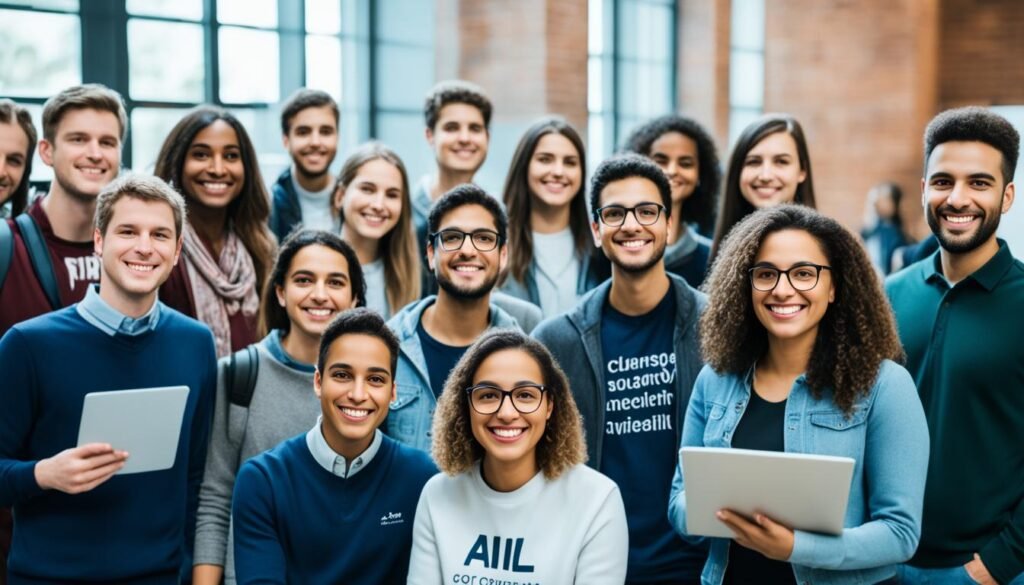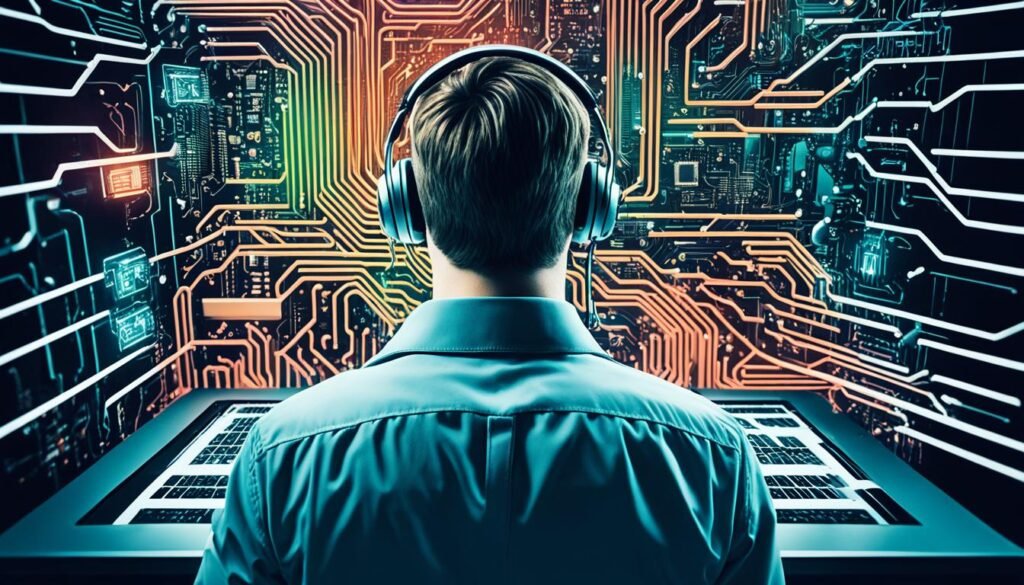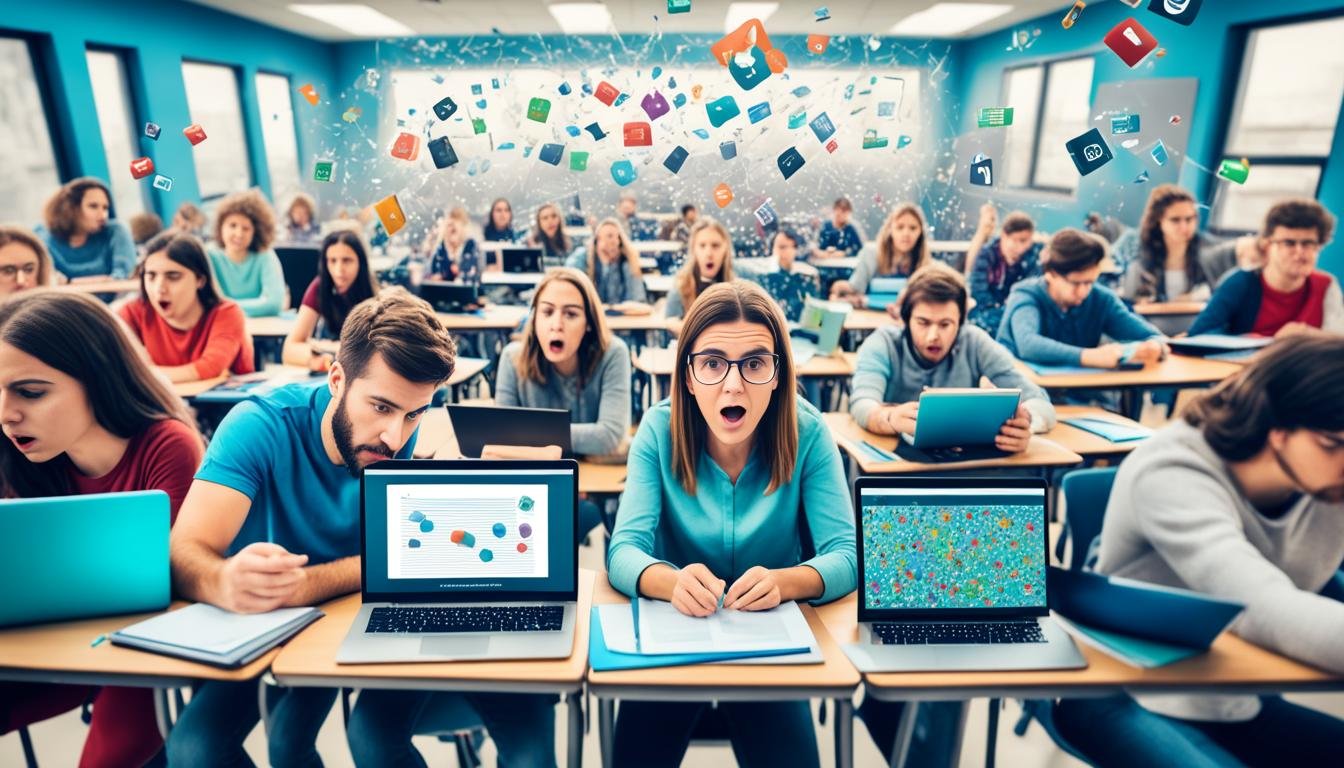Did you know that deepfakes, including AI-generated nude images, are already being used by kids to create inappropriate content of their classmates? This fact shows how urgent it is to tackle AI challenges in schools. AI tools like ChatGPT are becoming more common, used in many school areas. They help with everything from learning tools to facial recognition and even creating essays from prompts.
Bringing AI into education brings many concerns. These include biases, misinformation, environmental impacts, and ethical. For educators and students, it’s key to know these AI issues and how to deal with them.
Key Takeaways
- AI abuses like deepfakes and AI-generated pornographic content are a growing concern in schools
- AI tools can inherit and propagate biases, leading to issues like biased facial recognition technology
- Generative AI consumes significant energy and resources, contributing to environmental concerns
- Ethical issues around AI include lack of credit for content creators and data privacy challenges
- Plagiarism concerns are on the rise as students submit AI-generated work as their own
The Rise of Generative AI
Understanding Generative AI and Large Language Models
Generative AI has made huge strides, especially with large language models like GPT-3, GPT-4, ChatGPT, Bard, and Claude 2. These models learn from huge amounts of data, giving them a wide knowledge base. They can then use this knowledge for many tasks, from writing text to answering questions.
These AI systems are getting better fast, showing more general intelligence and almost human-like performance. But, they’re not perfect. They can sometimes give wrong or irrelevant info, making it hard to understand how they make decisions.
The growth of generative AI brings both good and bad news for schools. Schools need to rethink how they teach because of these new AI tools. It’s important for teachers to learn about AI and for students to get digital skills. This will help them succeed in an AI-filled future.
- Google released a 2-hour Generative AI for Educators course, and Amazon Educate has an Intro to Gen AI program.
- Khan Academy developed a learning coach Khanmigo, being piloted by about 4 dozen school systems.
- LAUSD partnered with AllHere on ED, an attendance chatbot evolving into a whole child acceleration platform.
- Santa Ana USD developed a comprehensive AI Compass: Your Guide to Navigating an AI World.
As more people use generative AI and large language models, teachers need to keep up. They should find new ways to use these technologies to help their students. This will prepare students for a future with lots of AI.

Current Concerns About AI in Education
AI in education has brought up many concerns for teachers. One big worry is AI being misused, like making deepfakes or AI-generated nude images. These threats can seriously harm student privacy and safety.
Another worry is bias and misinformation. AI can mirror biases in its training data, spreading wrong or misleading info. This is a big problem in schools, where students count on accurate info to learn and grow.
| Concern | Statistic |
|---|---|
| AI Abuses in Education | Seattle and New York City Public Schools, along with the Los Angeles Unified School District, have banned AI chatbots on their campuses due to concerns about academic dishonesty and the propagation of misleading information. |
| AI Biases in Education | According to a national survey by the Walton Family Foundation in May 2023, 75% of students believe that ChatGPT can help them learn faster, and 73% of teachers agree. |
| AI Privacy Concerns in Schools | Data systems collecting information about students for analysis and prediction are a primary concern in AI in education discussions. |
| AI Environmental Impact in Schools | The energy-intensive nature of AI models is another area of concern, as the environmental impact of these technologies must be carefully considered. |
The energy use of AI models is another worry. Issues like intellectual property, data privacy, and AI making the digital divide worse are also big concerns for teachers.
As AI becomes more common in schools, we must tackle these issues. We need to make sure AI is used responsibly and ethically. This way, we can focus on the education and well-being of our students.
Addressing AI Abuses and Biases
As AI becomes more common in schools, we must tackle its potential downsides. One important step is to teach students about the dangers of AI misuse, like deepfakes and creating content without consent. By focusing on consent and the wrong ways to use AI, teachers can help students understand empathy and responsibility.
It’s also vital to make students think critically about AI’s biases and limits. This helps them deal with the challenges AI brings. Plus, having strong privacy rules and checking AI tools for privacy and security issues is key to keeping student data safe and ethical.
Strategies for Handling AI Misuse
- Implement AI literacy programs to educate students about the harmful applications of AI, such as deepfakes and non-consensual content generation.
- Discuss the importance of consent and the consequences of misusing AI to help students develop empathy and responsibility.
- Encourage critical thinking about the biases and limitations of AI tools, using them as examples to illustrate algorithmic bias.
- Maintain robust privacy policies and vet AI products for potential privacy and security issues to protect student data.

By tackling AI’s downsides head-on, teachers can prepare students to use AI wisely and ethically. This approach is key to addressing ai abuses in education and teaching ai literacy. It’s also vital for protecting student privacy and consent in the fast-changing world of educational tech.
Mitigating Environmental and Ethical Concerns
As AI becomes more common in education, we must tackle its environmental and ethical sides. AI systems, especially big language models, use a lot of energy. This has big effects on the environment.
The environmental impact of AI is worrying. The tech sector uses about 1% of the world’s energy. But, new data centers and AI’s need for computing could increase energy use a lot. We need to find ways to use renewable energy for AI to reduce carbon emissions.
There are also big ethical issues with AI in education. Concerns include data privacy, bias in algorithms, and making the digital gap wider. We need to make decisions clear, design things inclusively, and talk with everyone involved.
To use AI in education right, we must have rules. These rules should protect student data and help avoid bias. By being open and responsible, we can make AI help all students fairly and efficiently.
| Ethical Concern | Mitigation Strategies |
|---|---|
| Data Privacy |
|
| Algorithmic Bias |
|
| Digital Divide |
|
By tackling the environmental and ethical issues of AI in education, we can make sure it’s used right. This will help students and the planet.

Combating AI-Enabled Plagiarism
AI-powered writing tools like ChatGPT are becoming more popular, making it harder for teachers to spot and stop AI plagiarism in schools. Surveys show that 49% of teachers now worry about plagiarism and cheating, up from 37% last year. Also, 22% of college students are using AI to help with their work or exams.
To fight this, teachers are getting proactive. Over half of them are now using software to prevent cheating, a big jump from 49% last year. They’re also setting rules and using tools to keep an eye on things, with a 45% increase in these efforts. But, only about a third of students know that using AI tools is against the rules.
Teachers are learning more about AI to better understand and stop AI plagiarism. They’re trying different methods like making questions random, not letting students go back on exams, asking for paper drafts, and getting to know AI platforms. Yet, 51% of students say they’ll keep using AI tools, even if told not to by teachers or schools.
AI detection tools can correctly spot AI-generated content between 33 to 81 percent of the time. This depends on the tool and how it works. Also, over half of TOEFL essays were wrongly marked as AI-made because of bias in the AI’s training data. This has made 80% of people doubt the effectiveness of AI detectors in finding AI-generated work.
Stopping AI plagiarism is a big challenge, but teachers can tackle it in many ways. They can promote honesty in school, set clear rules for AI use, and use more unique and emotional assessments. By tackling the reasons behind AI plagiarism, schools can keep student work honest and prepare students for the changing world of technology.
| Statistic | Value |
|---|---|
| Faculty members citing plagiarism and cheating as a challenge in 2022 | 37% |
| Faculty members citing plagiarism and cheating as a challenge in 2023 | 49% |
| College students who have used AI tools to complete assignments or exams | 22% |
| Faculty members using anti-cheating software in 2022 | 49% |
| Faculty members using anti-cheating software in 2023 | 52% |
| Faculty members utilizing prompts and safeguards in 2022 | 28% |
| Faculty members utilizing prompts and safeguards in 2023 | 45% |
| Students whose instructors, course materials, or school honor codes have prohibited the use of AI tools | 31% |
| Students whose instructors or schools haven’t clarified how to use AI tools ethically or responsibly | 60% |
| Students who would continue to use generative AI tools even if prohibited | 51% |
| Range of accuracy for AI detection tools | 33% to 81% |
| TOEFL essays incorrectly classified as AI-generated due to bias | Over 50% |
| Respondents with low confidence in AI detectors’ ability to identify AI-generated content | 80% |

“The integrity of student work is paramount, and we must address the root causes of AI-enabled plagiarism to ensure that our education system remains a bastion of authentic learning and academic excellence.”
Preparing for the AI-Driven Future
Potential Impacts of AI on Education
AI is changing the way we learn and work. It will greatly affect education, jobs, and the skills needed for the future. Teachers should talk to students about how AI will change jobs and what skills they’ll need to succeed.
Assignments that focus on AI’s impact and discussions on AI policies can prepare students. This helps them understand the challenges and chances ahead.
But, AI’s fast growth could make the digital divide worse. Not all students or schools may have equal access to AI tools. It’s important to make sure all students are ready for an AI-driven world.
AI can give teachers valuable insights, like showing learning trends and evaluating tests in new ways. It can also help with personalized tutoring, improving students’ grades and meeting their unique needs.
| Key Transformations for Education 4.0 | Potential AI Applications in Education |
|---|---|
|
|
AI shouldn’t replace teachers, but it can make learning better. Teachers should use AI tools wisely and see how AI can change education’s future.
“AI offers a solution to providing personalized tutoring by tailoring the learning experience to the individual, enhancing academic performance while catering to diverse learning needs.”
Harnessing the Power of AI in Education
AI in education faces big challenges, but it also has great benefits. Teachers can use AI tools like ChatGPT, Bard, and Claude 2 for lesson planning, making content, and personalized learning. These AI systems have strengths and limits. Teachers can use them well in class, saving time and resources. This lets them focus more on helping students one-on-one.
The UK’s Department for Education (DfE) is looking into how AI can improve education. They’re excited about AI’s ability to cut down on paperwork and help students more personally. A hackathon was held to tackle real education challenges. Teachers, leaders, and data scientists worked together on AI-powered lesson planning and content generation.
The DfE is giving money to Oak National Academy to add AI features like lesson planners and quizzes. This shows they see the benefits of AI in the classroom. AI can help teachers by doing some tasks automatically and offering virtual help. It also gives personalized tutoring and learning plans based on how students do.
- AI looks at lots of data to know what each student is good at and what they need to work on.
- AI tools make learning more fun and get students to take part more.
- AI can grade work and give feedback right away to students.
- AI looks at student data to spot trends and find where students might be falling behind.
- Learning systems that use AI change the level of the material based on how well a student is doing.
- AI helps students with disabilities get to educational materials and join in class activities.
When adding AI to the classroom, we must think about privacy and how student data is used. Teachers need to keep learning to use AI well and make sure everyone can use these AI-enabled educational resources and technologies.
“AI offers immense potential to revolutionize education, but it must be implemented thoughtfully and with a focus on enhancing the student experience, not replacing the teacher.”
Effectively Incorporating AI in the Classroom
AI is changing many industries, including education. To use AI well in schools, we need a careful plan. This plan should focus on the best ways to use AI, set rules for using it right, and make sure teachers are ready for AI.
Using AI in education means solving its challenges and issues. Teachers need the right skills and knowledge for AI tools. Programs that teach AI literacy and its limits are key to getting teachers ready for the future.
It’s important to have rules for using AI responsibly. This means looking at privacy and security, and checking if AI tools work well. By being proactive, schools can make learning better and deal with AI’s risks.
- Provide comprehensive professional development programs for teachers on AI literacy and best practices.
- Develop clear guidelines for the responsible use of AI in the classroom, addressing privacy, security, and ethical considerations.
- Continuously monitor the effectiveness of AI-powered resources and adjust implementation strategies as needed.
- Encourage teachers to engage with generative AI tools, such as ChatGPT, alongside students, fostering critical thinking and responsible use.
- Educate students on the capabilities and limitations of AI, empowering them to navigate the AI-driven future with confidence and discernment.
By being proactive, schools can make the most of AI to improve learning. This needs a team effort from teachers, policymakers, and tech companies. They must work together to use AI in a responsible and effective way.
| Opportunities | Challenges |
|---|---|
|
|
The way we teach is changing, and using AI in class is key to the future of learning. By following best practices and getting ready, schools can use AI to make learning better. This will help create a generation that thinks deeply and learns for life.
“Integrating cutting-edge technology like AI into education is crucial for preparing students for the future. Educators must embrace this transformation and guide students to navigate the AI-driven reality responsibly.”
– Houman Harouni, Education Lecturer, Harvard Graduate School of Education
Conclusion
AI in education brings both good and bad sides. Tools like ChatGPT, Bard, and Claude 2 could change how we teach and learn. But, they also bring up worries about misuse, bias, the environment, and ethics.
To tackle these issues, we need a wide-ranging plan. This plan should focus on teaching AI literacy, protecting privacy, being green, and ethical thinking.
By getting ready for an AI-filled future and using this tech wisely, teachers can make sure AI helps more than it hurts. This way, students will get a better learning experience. With careful planning, schools can handle AI’s challenges and help students succeed in a world full of AI.
As education changes, it’s key to keep a balance between new tech and the human element. By facing AI’s challenges and using its benefits, education can open up new doors. This ensures students are ready with the skills and knowledge needed for the future.
FAQ
What are the main concerns about AI in education?
AI in education raises worries about deepfakes and AI-made porn content. It also concerns biases and wrong information, harm to the environment, and ethical issues with intellectual property and data privacy.
How can educators address the potential abuses and biases of AI?
Teachers can tackle AI’s issues by teaching AI literacy. They should talk about consent and the dangers of misuse. Encouraging students to think critically about AI’s limits is key. They should also check AI products for privacy and security risks.
What are the environmental concerns related to AI in education?
AI’s big resource use is a big worry for the environment. Teachers can teach students about climate change and tech’s effects. They can also share ways to lessen AI’s harm on the planet.
How can educators address the threat of AI-enabled plagiarism?
To fight AI plagiarism, teachers need to know AI tools well. They should understand their students’ writing styles. More in-class writing and custom prompts that need emotional and personal insight can help.
Tools to spot AI-written text exist, but they’re not always right.
How can educators prepare students for the AI-driven future?
Teachers should talk to students about how AI will change jobs and what skills they’ll need. Assignments and discussions about AI’s effects can prepare them. Talking about AI rules and policies is also important.
How can educators effectively incorporate AI in the classroom?
Using AI in class needs careful planning. Teachers should get training on AI literacy and its limits. They must set clear AI use rules, focus on privacy and security, and check if AI tools work well.
